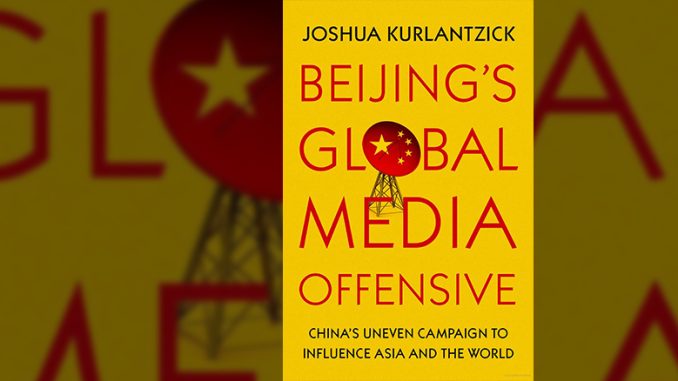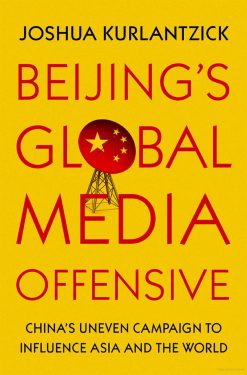
Title: Beijing’s Global Media Offensive: China’s Uneven Campaign to Influence Asia and the World
Author: Josh Kurlantzick
Oxford: Oxford University Press, 2022
Russian President Vladimir Putin was all smiles in the days before his invasion of Ukraine. So too was Chinese President Xi Jinping, who Putin hosted for a red carpet visit to Moscow during which the two leaders declared that their partnership had “no limits.”
Yet by all indications, Putin’s invasion surprised Xi. Russia’s paramount leader apparently did not detail his plans, which Xi appears to have considered imprudent. But Xi’s concern has not stopped Chinese officials and media from publicly expressing support for some aspects of the war and spreading outright falsehoods designed to reduce Western credibility and boost that of Moscow. “The moves by the US-led #NATO have pushed the #Russia-Ukraine tension to the breaking point,” tweeted the Chinese ambassador to the Association of Southeast Asia Nations (ASEAN), essentially blaming the West for the conflict. China’s state-run Xinhua news agency warned the United States to not “play with fire” and said that U.S. military support for Ukraine was aggravating U.S.-Russia tensions.
This months-long episode was anything but a one-off, as Josh Kurlantzick – a senior fellow at the Council on Foreign Relations and former journalist – points out in his excellent new book, Beijing’s Global Media Offensive: China’s Uneven Campaign to Influence Asia and the World. Rather, China’s Russia-related disinformation is only one small piece of Beijing’s broader global influence campaign which, despite some missteps, poses significant challenges for democracies everywhere.
China is certainly not exceptional in trying “present” itself in a “benign light,” as Kurlantzick makes clear from the start. The United States has long tried to do the same through outlets like Voice of America and Radio Free Europe.
But since Xi took power, Beijing’s goal has become broader, fitting “into a more assertive Chinese foreign policy overall.” Today, China’s “influence offensive” aims not just to make China look good as in the recent past but also to help Beijing reshape “the world in its own image” by promoting its own model of development; stoking divisions within and among democracies; strengthening existing autocracies; and undermining the image of democracy itself.
Central to Kurlantzick’s examination of Chinese efforts is his differentiation of soft and sharp power.
He defines soft power in a somewhat broader way than most do: as any kind of influence effort that does not involve “strategic, political, information, and economic coercion or distortion.” Soft power efforts, put simply, are fairly transparent and not coercive. When Chinese state media or diplomats celebrate China’s infrastructure drives or the birth of pandas at a Shenzhen zoo, that is soft power. These efforts come through “the front door.” They are not the result of shady deals happening in smoke-filled backrooms. They happen in public, meaning that keen readers can be aware of what the state-run China Daily and CGTN are, and what they support.
But here is where the line between soft and sharp power becomes difficult.
 CGTN’s broadcasting of positive stories about China is soft power, but the broadcaster’s content-sharing deals with major outlets everywhere are sharper. These content-sharing efforts are often clandestine and opaque; citizens and governments of the affected countries tend to be unaware of them. The same goes for when individuals or companies linked to the Chinese state purchase media outlets abroad and pressure them to publish pro-China reporting or stymie stories critical of China; when Chinese-linked firms buy or build the “pipes” of global media like telecommunications networks; when Beijing pays journalists or academics in return for favorable commentary; or when Chinese embassies punish Chinese students in their host countries for criticizing China.
CGTN’s broadcasting of positive stories about China is soft power, but the broadcaster’s content-sharing deals with major outlets everywhere are sharper. These content-sharing efforts are often clandestine and opaque; citizens and governments of the affected countries tend to be unaware of them. The same goes for when individuals or companies linked to the Chinese state purchase media outlets abroad and pressure them to publish pro-China reporting or stymie stories critical of China; when Chinese-linked firms buy or build the “pipes” of global media like telecommunications networks; when Beijing pays journalists or academics in return for favorable commentary; or when Chinese embassies punish Chinese students in their host countries for criticizing China.
Distinguishing between China’s use of the two powers is incredibly difficult. For example, China’s Confucius Institutes – which promote Chinese language study around the world – are a soft power program by nature. There is nothing “sharp” about teaching Americans, Brits, or Thais to speak Mandarin. But when those same Institutes infringe on academic freedom by limiting discussion about China, that is “a sharp power intrusion,” as the scholar Joseph Nye has written.
These Institutes’ evolution from mere language schools to ones that do often infringe on academic freedom reflects the broader shift in China’s influence campaign. Whereas China once focused on soft power, Beijing has in recent years invested more and more heavily in sharp power, with top officials seemingly believing China’s previous soft power drives to have been inadequate. Given the fact that China’s favorability rating had fallen across of much of Asia by the mid- and late-2010s despite huge sums spent on soft power, Beijing was not wrong in its pessimistic assessment.
But this is the ultimate conundrum of Beijing’s influence campaign: Its soft power efforts are not particularly successful in shaping global opinions of China, owing largely to the unconvincing nature of Chinese state media and limited foreign interest in Chinese cultural exports; but Beijing’s sharp power efforts are so aggressive – and so offensive to foreign governments and their publics when exposed – that they tend to fail, too.
CGTN’s pro-Beijing reporting did not exactly endear Australians to China. Australian investigations of Chinese state money flowing into Australian universities, coupled with Beijing’s ongoing economic coercion of Canberra, only made the situation worse for China. Much the same can be said of China’s failed effort to boost Han Kuo-yo in Taiwan’s 2020 presidential election with propaganda and disinformation.
If Beijing’s soft power is ineffective, its sharp power tends to be too sharp.
Perhaps the most troubling sections of Kurlantzick’s book, meanwhile, are his chapters on Xinhua’s public content-sharing deals – which have combined soft and sharp power to produce a rare influence success for China – and Chinese state media’s ability to slip through the “back door” by signing content-sharing deals that tend not to reveal China’s role in the partnership.
On the soft power front, Xinhua has gained global popularity by offering free content on often-under-covered stories, like Southeast Asian summits, to cash-strapped outlets hungry for content; gained credibility in advanced economies by partnering with outlets like the Associated Press; and boosted readership by sharing content with popular outlets in Germany, Greece, Poland, and beyond.
These moves have been so successful because they enable consumers to read Chinese state-generated content without choosing or even knowing it. That means that citizens – including citizens of democracies – are unknowingly imbibing Chinese propaganda, even if there might be a small “Xinhua” label in the top corner of the article. And as Kurlantzick demonstrates with the example of Thailand, widespread readership of such content can genuinely shape elite discourse on and thus policymaking towards China.
Some of China’s sharp power efforts have found success, too.
Chinese state-linked entities have on several occasions simply purchased newspapers and television channels in places like Australia and Southeast Asia, shifting their content in a more pro-China direction. The Chinese government has helped autocracies launch genuinely popular yet regime-friendly news sites like Cambodia’s Fresh News. Beijing also increasingly shapes global conversations by omitting China-critical content like WeChat and pushing pro-China disinformation on websites like Twitter.
Ultimately, though, Beijing’s record is “decidedly mixed,” as Kurlantzick notes throughout. Whereas Xinhua’s broadcasting and other Chinese state outlets’ burrowing into local media environments can constitute rare successes, China’s other soft power efforts have largely failed, while its sharp power moves are “sparking a backlash” and somewhat limiting Beijing’s ability to shape global narratives.
But this is no reason to be complacent, because “failure now does not mean failure forever.” China already spends more money on state media than any country including the United States. Xinhua is already somewhat successful. China already controls information pipes in many parts of the world. Combining vast spending with increased knowhow – and an ability to learn from mistakes – China could very well better shape the world in its image.
Kurlantzick recognizes that reality and offers several deceptively simple steps democracies can take to guard against it. He argues that our governments should, for starters, increase study of China’s influence campaigns; treat the media and information sector as “one of critical national security importance” and thus better understand their ownership structures; “pre-butt” Chinese disinformation campaigns by predicting and publicizing these efforts (as the Biden administration did vis-à-vis Russia’s pre-invasion efforts); support independent media around the world; move to limit Xinhua’s expansion; and, broadly, work to get our own democracies in order. Critically, though, he cautions against overly broad responses, which spend too much time on China’s failures and can at times veer into xenophobia, offering Beijing a ready-made talking point.
These solutions are smart and sensible. Given broad ideological agreement on the nature of the China challenge in countries as far afield as the United States, United Kingdom, the Czech Republic, and Japan, it certainly seems that democratic governments could implement some of these steps sooner rather than later.
If we cannot right our own ships, however, Kurlantzick warns that we will give China “greater room to grow to deploy its soft and sharp power tools – and much greater success as well.” His sober yet searing assessment leaves readers with little reason to disagree.
Reviewed by Charles Dunst
Charles Dunst, the author of the forthcoming Defeating the Dictators: How Democracy Can Prevail in the Age of the Strongman (Hodder & Stoughton, 2023), is deputy director of research and analytics at The Asia Group.
